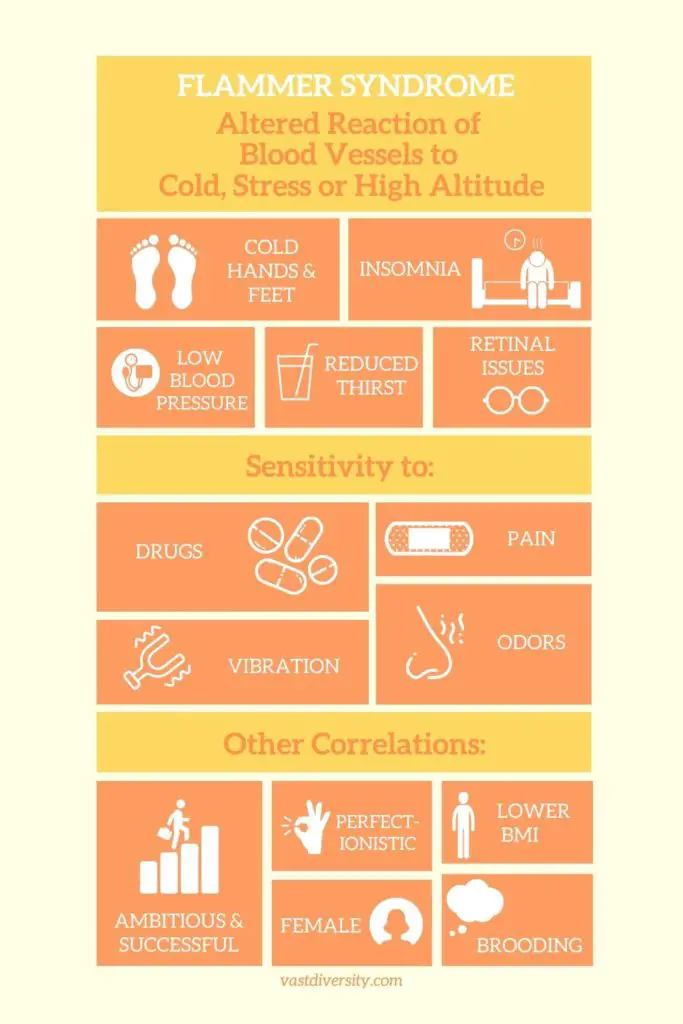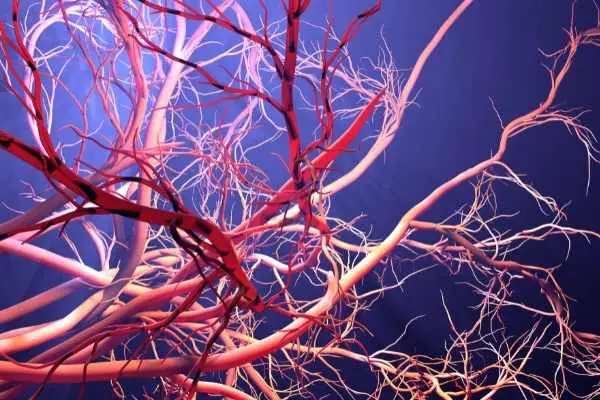Freezing cold hands, low blood pressure and insomnia. Does this describe you? You might have Flammer Syndrome, a condition caused by blood vessel dysregulation. Good news, there are treatment options that can help you thrive!
What is Flammer Syndrome? Cold Hands and Feet Syndrome
Flammer syndrome is a constellation of symptoms due to blood vessel dysregulation. With Flammer syndrome blood vessels react differently to stimuli like coldness, emotional stress, or hypoxia.
People with Flammer Syndrome can have cold hands and feet, insomnia, low blood pressure, reduced thirst, increased sensitivity certain stimuli, various retinal issues and other physical and psychological correlations.

Flammer Syndrome Symptoms – Cold Hands and Headache
Symptoms are what someone with a condition experiences.

Common Symptoms of Flammer Syndrome:
- Cold hands and/or feet
- Long sleep onset time
- Reduced feeling of thirst
- Increased sensitivity, e.g.:
- – increased response to certain drugs
- – increased smell sensitivity
- – increased pain sensitivity
- – increased high altitude sensitivity
- – increased meteorosensitivity
- – increased sensitivity to vibration
- Remarkable assiduousness up to tendency towards perfectionism
- Tinnitus
- Headaches
- Muscle cramps
Flammer Syndrome Signs – Cold Hands, Low Blood Pressure
Signs are observations that doctors see when they observe or examine a patient.
Note – not all of these signs are present in every person with Flammer Syndrome. These are just signs that are often seen in Flammer syndrome, and some are more common that others.

General Signs of Flammer Syndrome:
- Skin temperature redistribution (distal extremities are colder; trunk is warmer)
- Increased skin temperature inhomogeneity under emotional stress (up to reversible red and white skin blotches)
- Low blood pressure; blood pressure drops especially at night
- Low body mass index
- Prolonged flow cessation after cold provocation, Reduced blood flow velocity in the Nailfold capillaroscopy
- Silent myocardial ischemia
- Altered activity of the autonomic nervous system (beat-to-beat variation)
- Slightly elevated plasma endothelin-1 level
- Altered gene expression (measured in lymphocytes)

Ocular Signs of Flammer Syndrome:
- Reduced capacity to autoregulate ocular blood flow
- Correlation between the optic nerve head and peripheral blood flow
- Increased stiffness of retinal vessels
- Higher spatial irregularities in retinal vessels
- Reduced neurovascular coupling (endotheliopathy)
- Increased retinal venous pressure
- Increased blood flow resistance in retroocular vessels

Before we talk about treatment, let’s talk about what is going on with Flammer Syndrome. Because when you understand something, then you can more clearly think about how to treat it.
Flammer Syndrome: Genetic?
So what is going on in people who have Flammer Syndrome?
What is happening is dysregulation of the blood vessels, specifically endothelial dysfunction. The lining of the blood vessels is not reacting properly.
What is causing this? Well, probably something genetic. Dr. Flammer noted that his patients with cold hand reported having other family members with the same issue.

People with Flammer Syndrome have higher concentrations of a hormone called Endothelin-1 (ET-1). Endothelin-1 is involved in the mediation of oxidative stress and inflammation in the body.
Endothelin-1 and nitrous oxide regulate local vascular tone when properly balanced. So this lack of balance may be the reason for the vasospasm.
Flammer Syndrome Traits: Explained by Endothelin-1 Imbalance?
Now this vascular regulation is all very complicated, and needs to be studied in more detail. But it has been suggested that it is microvascular dysfunction may be the cause of many of the traits seen in Flammer Syndrome.
(Microvascular means the really small blood vessels. Like in your fingers, in your eyes, in various organs, and … in your brain.)

Why do more women have Flammer Syndrome? Well, this may be explained by the fact that sex hormones affect endothelin levels.
Dr. Flammer noticed that a lot of his patients exercised a lot. It may be that they were doing this to adjust their levels of Endothelin-1 (ET-1). Aerobic exercise can decrease levels of ET-1.
The fact that there are these various sensitivities? (To smells, vibrations, physical pain, drug sensitivities etc) ET-1 is involved in regulation of the senses, with Endothelin receptors greatly expressed in the olfactory mucosa which is how we smell. ET-1 also modulates pain and drug sensitivity.
The psychological sensitivity? Well, emotional pain and physical pain can be regulated very similarly in the body. Endothlin-1 modulates stress reactions and mental health.
The autonomic imbalance with sympathetic predominance and lower heart rate variability? Endothelin-1 is a trigger for pro-inflammatory pathways and also involved in the regulation of the adrenal gland.
Flammer Syndrome: Treatment
Ok, so researach is ongoing to understand Flammer Syndrome, but you have a lot of these traits. What should you do?
Dr. Flammer’s treatment of Flammer Syndrome is based on:
- Lifestyle management
- Nutrition
- Supplements and drug therapy

Flammer Syndrome Treatment: Lifestyle Management
- Avoid getting cold and avoid stress as much as possible.
- Recognize how your body feels when under stress. If this is difficult for you, using a feeling wheel to recognize feelings and doing body scans can help you to learn skills.
- Recognize your stress triggers and avoid or reduce as much as possible.
- Find relaxation techniques that work for you. There are many many options like yoga, meditation, breathing techniques like the physiological sigh, visualization techniques, Non-Sleep Deep Rest Protocols like yoga nidra or self-hypnosis, and polyvagal exercises.

- Get good sleep. Having cold feet will affect your ability to fall asleep so taking a warm bath before bed or wearing socks can help. One study showed that using a warm eye pack before bed also helped reduce insomnia.
- Exercise but not excessively.
- Do not smoke, for many reasons but it causes vasoconstriction, the exact thing we are trying to avoid with a vasospasm problem.
- Take extra time for adaptation if going to a high altitude.
- That lack of thirst means you need to hydrate with electolytes!

Flammer Syndrome Treatment: Nutrition
- An antioxidative diet to reduce oxidative stress. Increasing plant based foods, seeds, nuts is a good start. A ketogenic diet may also be helpful.
- Omega-3 fatty acids, either in your diet or with supplements.
- You may need to avoid fasting – it can trigger symptoms
- Symptoms may be worse with lower BMI
- Salt can help to increase blood pressure

Flammer Syndrome Treatment: Supplements & Drug Therapy
- First of all, speak to your physician to make sure any of these options is right for you.
- Magnesium reduces vascular dysfunction, oxidative stress and retinal cell apoptosis (cell death). Magnesium also helps with peripheral circulation, so should help with the cold hands and feet. Dr. Flammer recommends a very high dose of Magnesium supplementation (which if you are taking Magnesium Citrate may cause diarrhea – Yikes!). Magnesium L-threonate, which is better absorbed into the brain might be a better option.
- Ginkgo biloba extract has been shown to increase ocular blood flow in normal tension glaucoma patients. Studies involved taking 40mg pills 3 times a day.
- CoEnzyme Q10 has been shown to reduce oxidative stress in mice models of glaucoma.
- Melatonin also has an antioxidative role. While melatonin can be taken as a supplement, it is naturally produced by our body. There are really easy and surprisingly powerful ways to increase the natural levels of melatonin with proper light exposure.
- A calcium channel blocker may help with circulation (doctor’s prescription required). But… a very low dose is recommended, because Calcium channel blockers can decrease blood pressure, which may already be low in someone with Flammer Syndrome.
- You may need to avoid certain drugs that are vasoconstrictive
- Other drugs may need to be taken at a lower dose.
- There is ongoing research into new drugs that target ET-1 such as clazosentan and ambrisentan.
Flammer Syndrome Treatment Alternative: Wim Hof Breathing Techniques?
Wim Hof, also known as the ‘Ice Man’ is proponent of hyperventilation hypocarbic breathing and cold exposure.

In his book ‘The Wim Hof Method’ he details a very specific breathing technique that he says will help you stay warm. Apparently he used it to keep his body temperature stable during a cold exposure experiment.
Are you one of those people who feels cold all the time? Would you like to be able to warm your body even when you don’t have access to an external heat source?
Wim Hof in ‘The Wim Hof Method’
He goes on to describe this breathing technique to activate brown fat tissue and your intercostal muscles (muscles between the ribs):
- Sit down
- Inhale slowly and deeply five or six times, letting your breath go naturally each time
- Inhale fully
- Relax to exhale
- Inhale fully
- Hold your breath, for no more than 5 seconds
- Tense your upper-back muscles and chest while you hold your breath – but don’t tense the head. Keep your jaw relaxed.
- Let go

He also feels that cold exposure will train the body to reregulate blood flow and be able to withstand the cold. He suggests this exercise for warmer hands and feet:
- Fill a bucket with 1/3 ice and 2/3 water
- Redirect your mental focus to your hands (or feet)
- Place your hands or feet into the ice bucket
- Hold your hands or feet in the bucket for two minutes. At some point they should start to feel warm instead of cold.
- Remove your hands or feet from the ice bucket, but keep your mental focus on them.
- Shake them out several times to encourage the blood flow into your newly awakened extremities.

He believes that this exercise will retrain the muscles around the veins in your hands. By doing this exercise daily, adaptation occurs and your hands will not be so cold anymore.
Ok! Clearly a different approach from Dr. Flammer’s suggestion to avoid cold and stress. But there is a new thinking that exposing ourselves to small doses of acute stress can help us be able to deal better with chronic stress.

And maybe that is really what we are dealing with in Flammer Syndrome – a chronic stress response with multiple effects throughout the body.
And if so, that explains why there is no one easy fix. It is about making your whole body and self feel safe and calm, which will reduce the unpleasant symptoms and improve your life.

References
- The discovery of the Flammer syndrome: a historical and personal perspective
- Individualised patient profile: clinical utility of Flammer syndrome phenotype and general lessons for predictive, preventive and personalised medicine
- The primary vascular dysregulation syndrome: implications for eye diseases
- Flammer syndrome
- Periocular skin warming promotes body heat loss and sleep onset: a randomized placebo-controlled study
- Melatonin differentially affects vascular blood flow in humans
- Endothelin-1 axes in the framework of predictive, preventive and personalised (3P) medicine
- Glaucoma: Lifestyles of the Antioxidant Rich and Famous
- The Wim Hof Method: Activate Your Full Human Potential